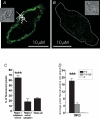TRPC3 properties of a native constitutively active Ca2+-permeable cation channel in rabbit ear artery myocytes
- PMID: 16396924
- PMCID: PMC1413579
- DOI: 10.1113/jphysiol.2005.102780
TRPC3 properties of a native constitutively active Ca2+-permeable cation channel in rabbit ear artery myocytes
Abstract
Previously we have described a constitutively active, Ca2+-permeable, non-selective cation channel in freshly dispersed rabbit ear artery myocytes which has similar properties to some of the canonical transient receptor potential (TRPC) channel proteins. In the present work we have compared the properties of constitutive channel activity with known properties of TRPC proteins by investigating the effect of selective anti-TRPC antibodies and pharmacological agents on whole-cell and single cation channel activity. Bath application of anti-TRPC3 antibodies markedly reduced channel activity in inside-out patches and also produced a pronounced reduction of both current amplitude and variance of constitutively active whole-cell cation currents whereas anti-TRPC1/4/5/6/7 antibodies had no effect on channel activity. In the presence of antigenic peptide, anti-TRPC3 antibodies had no effect on whole-cell or single cation channel activity. Bath application of flufenamic acid, Gd3+, La3+ and Ca2+ inhibited spontaneous channel activity in outside-out patches with IC50 values of 6.8 microm, 25 nm, 1.5 microm and 0.124 mm, respectively, which are similar values to those against TRPC3 proteins. Immunocytochemical studies combined with confocal microscopy showed expression of TRPC3 proteins in ear artery myocytes, and these were predominately distributed at, or close to, the plasma membrane. These data provide strong evidence that native constitutively active cation channels in rabbit ear artery myocytes have similar properties to TRPC3 channel proteins and indicate that these proteins may have an important role in mediating this conductance.
Figures




Similar articles
-
Angiotensin II activates two cation conductances with distinct TRPC1 and TRPC6 channel properties in rabbit mesenteric artery myocytes.J Physiol. 2006 Dec 1;577(Pt 2):479-95. doi: 10.1113/jphysiol.2006.119305. Epub 2006 Sep 14. J Physiol. 2006. PMID: 16973707 Free PMC article.
-
Role of phospholipase D and diacylglycerol in activating constitutive TRPC-like cation channels in rabbit ear artery myocytes.J Physiol. 2005 Aug 1;566(Pt 3):769-80. doi: 10.1113/jphysiol.2005.090852. Epub 2005 May 26. J Physiol. 2005. PMID: 15919706 Free PMC article.
-
Endothelin-1 activates a Ca2+-permeable cation channel with TRPC3 and TRPC7 properties in rabbit coronary artery myocytes.J Physiol. 2007 May 1;580(Pt.3):755-64. doi: 10.1113/jphysiol.2006.126656. Epub 2007 Feb 15. J Physiol. 2007. PMID: 17303636 Free PMC article.
-
The TRPC3/6/7 subfamily of cation channels.Cell Calcium. 2003 May-Jun;33(5-6):451-61. doi: 10.1016/s0143-4160(03)00056-3. Cell Calcium. 2003. PMID: 12765690 Review.
-
TRPC3: a versatile transducer molecule that serves integration and diversification of cellular signals.Naunyn Schmiedebergs Arch Pharmacol. 2005 Apr;371(4):251-6. doi: 10.1007/s00210-005-1054-6. Naunyn Schmiedebergs Arch Pharmacol. 2005. PMID: 15889239 Review.
Cited by
-
Ins(1,4,5)P3 interacts with PIP2 to regulate activation of TRPC6/C7 channels by diacylglycerol in native vascular myocytes.J Physiol. 2010 May 1;588(Pt 9):1419-33. doi: 10.1113/jphysiol.2009.185256. Epub 2010 Mar 8. J Physiol. 2010. PMID: 20211974 Free PMC article.
-
Transient receptor potential (TRP) channels, vascular tone and autoregulation of cerebral blood flow.Clin Exp Pharmacol Physiol. 2008 Sep;35(9):1116-20. doi: 10.1111/j.1440-1681.2007.04855.x. Epub 2008 Jan 21. Clin Exp Pharmacol Physiol. 2008. PMID: 18215190 Free PMC article. Review.
-
Flufenamic acid as an ion channel modulator.Pharmacol Ther. 2013 May;138(2):272-84. doi: 10.1016/j.pharmthera.2013.01.012. Epub 2013 Jan 25. Pharmacol Ther. 2013. PMID: 23356979 Free PMC article. Review.
-
Angiotensin II activates two cation conductances with distinct TRPC1 and TRPC6 channel properties in rabbit mesenteric artery myocytes.J Physiol. 2006 Dec 1;577(Pt 2):479-95. doi: 10.1113/jphysiol.2006.119305. Epub 2006 Sep 14. J Physiol. 2006. PMID: 16973707 Free PMC article.
-
ACh-induced depolarization in inner ear artery is generated by activation of a TRP-like non-selective cation conductance and inactivation of a potassium conductance.Hear Res. 2008 May;239(1-2):20-33. doi: 10.1016/j.heares.2008.01.005. Epub 2008 Jan 20. Hear Res. 2008. PMID: 18313244 Free PMC article.
References
-
- Ahmmed GU, Mehta D, Vogel S, Holinstat M, Paria BC, Tiruppathi C, Malik AB. Protein kinase Cα phosphorylates transient receptor potential channel-1 (TRPC1) and regulates store-operated Ca2+ entry. Role in signalling increased endothelial permeability. J Biol Chem. 2004;279:20941–20949. - PubMed
Publication types
MeSH terms
Substances
Grants and funding
LinkOut - more resources
Full Text Sources
Miscellaneous

